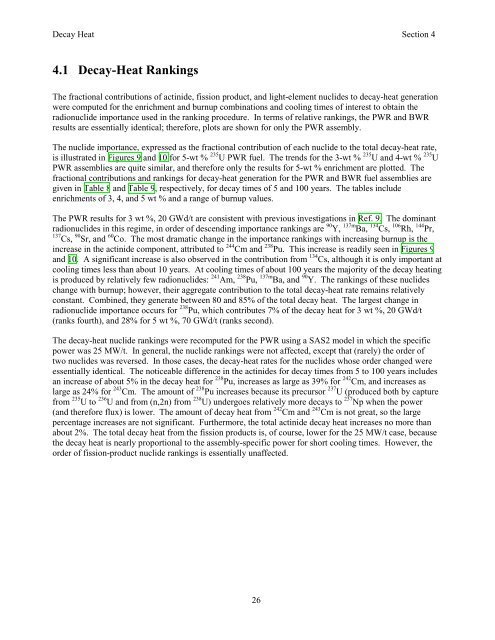nureg/cr-6700 - Oak Ridge National Laboratory
nureg/cr-6700 - Oak Ridge National Laboratory
nureg/cr-6700 - Oak Ridge National Laboratory
You also want an ePaper? Increase the reach of your titles
YUMPU automatically turns print PDFs into web optimized ePapers that Google loves.
Decay Heat Section 4<br />
4.1 Decay-Heat Rankings<br />
The fractional contributions of actinide, fission product, and light-element nuclides to decay-heat generation<br />
were computed for the enrichment and burnup combinations and cooling times of interest to obtain the<br />
radionuclide importance used in the ranking procedure. In terms of relative rankings, the PWR and BWR<br />
results are essentially identical; therefore, plots are shown for only the PWR assembly.<br />
The nuclide importance, expressed as the fractional contribution of each nuclide to the total decay-heat rate,<br />
is illustrated in Figures 9 and 10 for 5-wt % 235 U PWR fuel. The trends for the 3-wt % 235 U and 4-wt % 235 U<br />
PWR assemblies are quite similar, and therefore only the results for 5-wt % enrichment are plotted. The<br />
fractional contributions and rankings for decay-heat generation for the PWR and BWR fuel assemblies are<br />
given in Table 8 and Table 9, respectively, for decay times of 5 and 100 years. The tables include<br />
enrichments of 3, 4, and 5 wt % and a range of burnup values.<br />
The PWR results for 3 wt %, 20 GWd/t are consistent with previous investigations in Ref. 9. The dominant<br />
radionuclides in this regime, in order of descending importance rankings are 90 Y, 137m Ba, 134 Cs, 106 Rh, 144 Pr,<br />
137 Cs, 90 Sr, and 60 Co. The most dramatic change in the importance rankings with in<strong>cr</strong>easing burnup is the<br />
in<strong>cr</strong>ease in the actinide component, attributed to 244 Cm and 238 Pu. This in<strong>cr</strong>ease is readily seen in Figures 9<br />
and 10. A significant in<strong>cr</strong>ease is also observed in the contribution from 134 Cs, although it is only important at<br />
cooling times less than about 10 years. At cooling times of about 100 years the majority of the decay heating<br />
is produced by relatively few radionuclides: 241 Am, 238 Pu, 137m Ba, and 90 Y. The rankings of these nuclides<br />
change with burnup; however, their aggregate contribution to the total decay-heat rate remains relatively<br />
constant. Combined, they generate between 80 and 85% of the total decay heat. The largest change in<br />
radionuclide importance occurs for 238 Pu, which contributes 7% of the decay heat for 3 wt %, 20 GWd/t<br />
(ranks fourth), and 28% for 5 wt %, 70 GWd/t (ranks second).<br />
The decay-heat nuclide rankings were recomputed for the PWR using a SAS2 model in which the specific<br />
power was 25 MW/t. In general, the nuclide rankings were not affected, except that (rarely) the order of<br />
two nuclides was reversed. In those cases, the decay-heat rates for the nuclides whose order changed were<br />
essentially identical. The noticeable difference in the actinides for decay times from 5 to 100 years includes<br />
an in<strong>cr</strong>ease of about 5% in the decay heat for 238 Pu, in<strong>cr</strong>eases as large as 39% for 242 Cm, and in<strong>cr</strong>eases as<br />
large as 24% for 243 Cm. The amount of 238 Pu in<strong>cr</strong>eases because its precursor 237 U (produced both by capture<br />
from 235 U to 236 U and from (n,2n) from 238 U) undergoes relatively more decays to 237 Np when the power<br />
(and therefore flux) is lower. The amount of decay heat from 242 Cm and 243 Cm is not great, so the large<br />
percentage in<strong>cr</strong>eases are not significant. Furthermore, the total actinide decay heat in<strong>cr</strong>eases no more than<br />
about 2%. The total decay heat from the fission products is, of course, lower for the 25 MW/t case, because<br />
the decay heat is nearly proportional to the assembly-specific power for short cooling times. However, the<br />
order of fission-product nuclide rankings is essentially unaffected.<br />
26

















